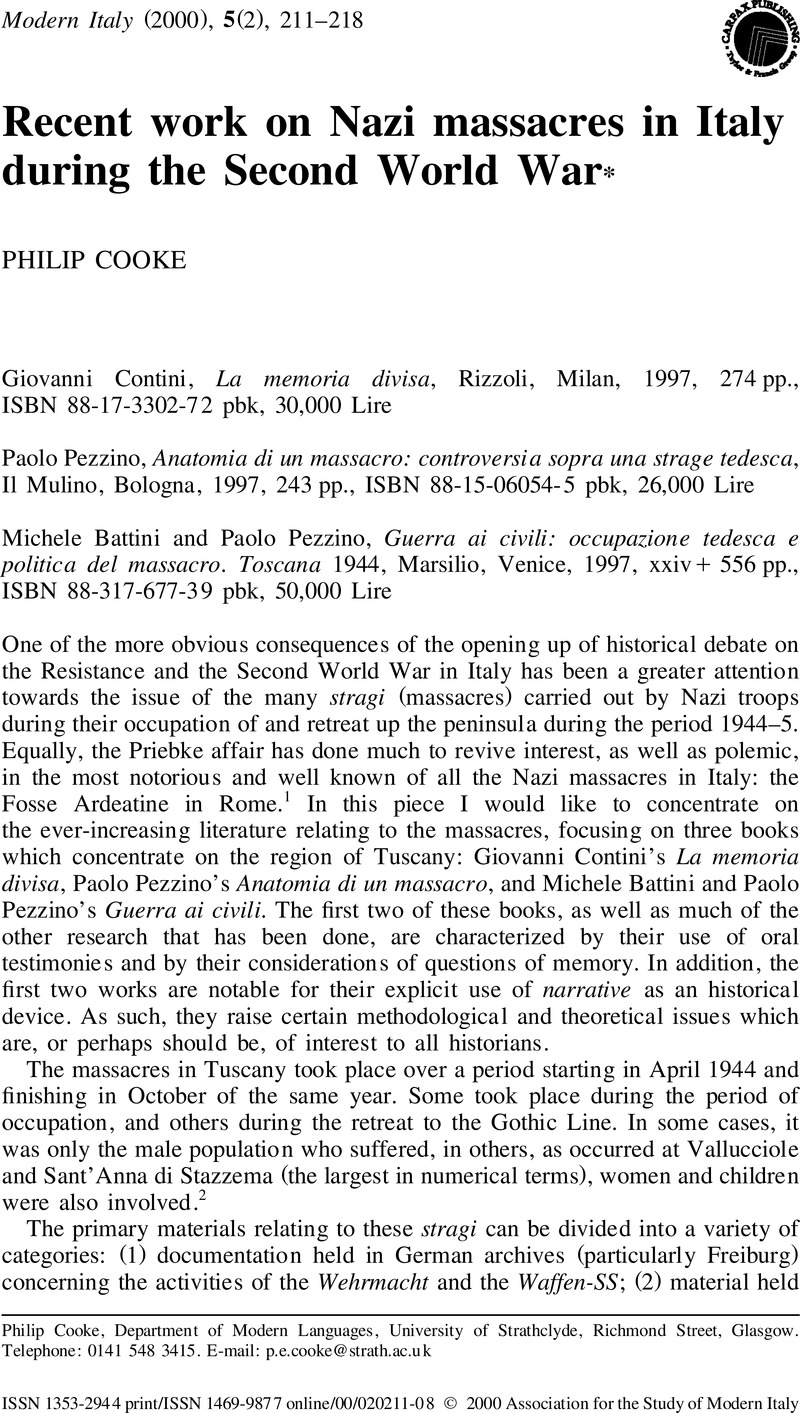Article contents
Recent work on Nazi massacres in Italy during the Second World War∗
Published online by Cambridge University Press: 18 May 2016
Abstract

- Type
- Review Articles
- Information
- Copyright
- Copyright © Association for the study of Modern Italy
References
Notes
1. A visit to Via Rasella itself fully demonstrates the enduring nature of this event in Roman memory. The bullet holes are still there and political graffiti regularly adorns the walls at the top end of the street. On my most recent visit the graffiti read: ‘Uno, dieci, cento Via Rasella’ (One, ten, a hundred Via Rasellas).Google Scholar
2. There has been much distasteful debate over numbers. It seems perverse that the map of the stragi provided by the Giunta Regionale Toscana should indicate Sant'Anna, with in excess of 400 victims, with a silver star. The map is, however, useful to give an idea of the geographical and chronological spread of the stragi. The volume Un percorso della memoria, edited by Matta, Tristano (Electa, Milan, 1996) contains a map covering all the stragi in Italy during the period 1943–5, and distinguishes typographically between stragi in which the victims were principally civilians and those in which the victims were principally partisans.Google Scholar
3. See Bilenchi, Romano, Cronache degli anni neri, Riuniti, Rome, 1984.Google Scholar
4. Schreiber, Gerhard, ‘La documentazione dell'Archivio militare tedesco a Friburgo e i massacri dei civili in Italia’, conference paper presented at Identità e storia della Repubblica. Per una politica della memoria nell'Italia d'oggi (Rome 27–28 June 1997, p. 1). I am grateful to Franca Franchi of the Istituto Gramsci, Rome, for providing me with a copy of this paper. More recently, however, Carlo Gentile has discovered evidence in the same Freiburg archives studied by Schreiber which link the Civitella massacre to a named division. This information has been passed to the military tribunal at La Spezia. Schreiber's Deutsche Kriegsverbrechen in Italien has been translated into Italian as La vendetta tedesca: 1943–1945, le rappresaglie naziste in Italia, Mondadori, Milan, 2000.Google Scholar
5. The ‘Romanization’ of the memory of the stragi is a wider issue which merits more detailed attention than is possible in this piece. For the time being I would merely point to the vast amount of literature on Via Rasella, and to the fact that the site of the massacre is the only Resistance-related cemetery which is run by the state.Google Scholar
6. Pisanò's articles first appeared in the weekly Gente in 1960 (numbers 34–51). These were followed up by the volume Sangue chiama sangue, Pidola, Milan, 1962, and the multi-volume Storia della guerra civile in Italia, Edizioni Val Padana, Milan, 1965. On the whole issue of the neo-fascist depiction of the war see Mario Isnenghi's excellent ‘La guerra civile nella pubblicistica di destra’, Rivista di Storia Contemporanea, 1989, pp. 104–15.Google Scholar
7. There had, however, been an earlier conference in Arezzo in 1988, organized by Tognarini, Ivan.Google Scholar
8. See Paggi, Leonardo (ed.), La memoria del Nazismo nell'Europa di oggi, La Nuova Italia, Florence, 1997.Google Scholar
9. Paggi, Leonardo (ed.), Storia e memoria di un massacro ordinario, Manifestolibri, Rome, 1996.Google Scholar
10. Paggi, Leonardo (ed.), Le memorie della repubblica, La Nuova Italia, Florence, 1999. Most of the papers in this volume were originally presented at the Rome conference in June 1997 (see n. 4 above). It is a shame that the book contains no trace of the most exciting exchange at the conference when, in response to Lutz Klinkhammer and Wolfgang Schieder's suggestion that Italian historians should also look at the massacres carried out by Italian soldiers in Africa, Paggi retorted that perhaps they should address their comments to the growing ranks of the apologists of Fascism.Google Scholar
11. It is interesting that a similar memory of a ‘good German’ exists in the memory of the people of Sant'Anna di Stazzema who believe that they found the body of a German soldier piled up alongside the dead by the church. This information is from Ennio Mancini, director of the museum at Sant'Anna.Google Scholar
12. The literature on this debate is quite extensive—for the ‘friendly fire’ thesis and relevant bibliography see, above all, Klinkhammer, Lutz, L'occupazion e tedesca in Italia, Bollati Boringhieri, Turin, 1993, p. 383. On San Miniato, see also Paoletti, Paolo, 1944 San Miniato: tutta la verità sulla strage, Mursia, Milan, 2000, which argues that the explosion was due to an American bomb.Google Scholar
13. Klinkhammer, , L'occupazion e tedesca, pp. 343–5, 367.Google Scholar
14. The original reads as follows: ‘Il criterio se il nemico con le sue rappresaglie e la sua reazione ci potrà portare colpi ancora più duri, non può essere preso in considerazione … Ma il fatto è che la convenienza o meno della lotta non si può misurare col metro del caso per caso; la lotta partigiana … si deve valutare sempre e solo nel quadro generale politico e militare della lotta contro il nazismo e il fascismo: il morto tedesco non si può contrapporre ai dieci ostaggi fucilati, ma si devono considerare tutte le misure di sicurezza che il nemico deve prendere, tutta l'atmosfera di diffidenza e di paura che questo crea nelle file nemiche …’ Google Scholar
- 1
- Cited by




